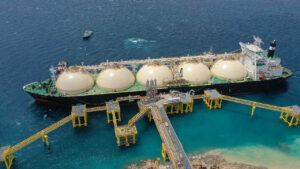THE Department of Energy (DoE) said on Tuesday that it is considering offering liquefied natural gas (LNG) capacity to participants in the fourth round of the Green Energy Auction (GEA) this year.
“With the anticipated entry of renewable energy into the grid resulting from the GEA, the DoE is considering liquefied natural gas (capacity) for the upcoming GEA-4,” the DoE said in a statement.
The DoE sees LNG as a reliable source of energy for the transition to greener forms of power.
The DoE said it will conduct “a series of studies and simulations on the impacts (of adding LNG power), such as price, dispatch, contracts, energy and capacity.”
GEA-4 covers integrated renewable energy and energy storage systems (IRESS), which the DoE described as “a comprehensive energy solution that combines renewable energy technology with energy storage systems.”
Energy storage systems include batteries and flywheel or pump storage hydropower systems.
“By combining renewable energy and energy storage, IRESS enhances the stability and reliability of the energy system, enabling a more consistent and efficient supply of power,” the DoE said.
Energy Undersecretary Rowena Cristina L. Guevara said the DoE is currently collaborating with development partners in studying the design and economic viability of IRESS.
The DoE said it will release the indicative timeline of GEA-4 activities in the coming months, when it expects to issue a notice of auction.
The GEA program aims to promote renewable energy as one of the country’s primary sources of energy through competitive selection.
GEA was first conducted in 2022 and attracted 1,996.93 megawatts (MW) worth of bids for renewables, while GEA-2 was held in 2023 and awarded 3,440.756 MW.
In a separate statement, the DoE said that two companies have completed their offshore 3D seismic surveys — Israel’s Ratio Petroleum Ltd. in the east Palawan basin for Service Contract (SC) No. 76. and PNOC Exploration Corp. in the northwest Palawan basin for SC 57.
The surveys covered 1,619 square kilometers in SC 76 and 1,519 square kilometers in SC 57.
The seismic data collected will facilitate “a better understanding of the geological characteristics of the east Palawan and northwest Palawan basins, aiding in the assessment of the basin’s oil and gas potential.”
“The completion of these surveys marks a significant milestone in the nation’s petroleum exploration efforts, underscoring the DoE’s commitment to pursuing high-impact activities to support inclusive economic growth and societal advancement,” Energy Secretary Raphael P.M. Lotilla said. — Sheldeen Joy Talavera
